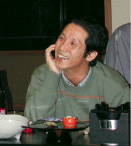3 June 1949 – 10 February 2009

Since our close friend Hideo Tamai passed away, several memorial ceremonies honouring him have taken place within interventional cardiology communities worldwide. We are heartened by the great affection shown towards him by his international colleagues, and appreciate the courtesy they have kindly extended. However, we are not really surprised, as their response is a testament to his profound influence upon our communities. Like tolling a bell at his death, we describe how Hideo had impacted the Japanese and international interventional cardiology fields.
Hideo Tamai started his career as an interventional cardiologist in September of 1984. During the 1980’s, he dedicated his clinical research to direct PCI of AMI, acute and long-term results of complex PCI for three-vessel disease or LMT disease and aortic valvuloplasty. Shortly afterwards, he became known as an aggressive operator among Japanese cardiologists and consequently was at the forefront of subsequent clashes with cardiac surgeons. In the late 1980’s, his skill set in complex PCIs, especially PCI of LMT which was his lifework, had reached the level of PCI as we now know it today and he had been acknowledged as an outstanding PCI operator. It was in the early 1990’s that we first met Hideo and immediately appreciated him as a professional pioneer, one who was eager to network between the Japanese interventionalists with their European and American colleagues. Although he had initiated his work in areas such as PCI of LMT, chronic total occlusions and pharmacological prevention of restenosis in the 1980’s, most of his scientific work1-4 in those areas evolved and came to light in the 1990’s when he had already earned worldwide recognition. He was a true pioneer in LMT-PCI and is acknowledged as one of the forefathers of the biodegradable stent, having invented the Igaki-Tamai stent back in 1990 and performed FIM studies in the 1990’s. Furthermore, he was instrumental in the formation of our Complex Catheter Therapeutics (CCT) live demonstration course, having developed and managed live demonstration courses which were predecessors to the CCT since 1992 in the face of significant difficulties and persecution. He played an important role as both an operator and organiser to the CCT, and was key in making it thrive as a successful international meeting which it continues to be to this day. The extreme level of complexity of the cases routinely performed at this meeting fit exactly with his vision and personality.
One of Hideo’s most admired traits as an operator was his willingness to show his procedures unedited, displaying an openness not often seen in live demonstration courses. He felt a responsibility to show, not only the good but also the not so good, a philosophy he carried over to his practice. Even though he had a heroic and fearless nature as an operator, he had a deeply empathetic approach to his patients and their families. We will never forget the dedication he had towards his job and his patients and the honesty by which he approached both.
However, it was not just his achievements or distinctions as an operator that we all admired, but also his strong conviction to do what he believed was right, even if it was against convention. He was always firm in this belief. He was never unnerved during complex PCI procedures or in his daily life. He never lost his wonderful sense of humour and ability to cheer up his friends, even in strained moments, and always remained open-minded. He displayed this strength as chairman of the Japanese Society of Interventional Cardiology (JSIC; 2003-2006) during which time he reinvented the JSIC despite strong, dissenting voices against his ideas. His persistence eventually led to the recent fruitful reorganisation of the JSIC. This strength of character and even-minded disposition was further evident throughout his final illness. Despite the seriousness of his disease and dire prognosis, he continued to work at the job he loved and successfully completed three complex CTO cases as the main operator along with Nicolaus Reifart as the co-operator during a live case at CCT 2009, only several days before his untimely death.
To use an analogy from the sport he loved, in many ways Hideo viewed his cathlab as his own sumo ring within which he confronted and defeated his detractors and proved himself to be a great innovator of procedural techniques. In fact, we often personally found ourselves as his opponent. Hideo was a formidable competitor, but our battles with him were always friendly and creative and they often inspired us with new ideas. A true yokozuna (highest rank of professional sumo) of the interventional world, Hideo will long be missed and never forgotten.
Grateful thanks to Mr. Wayne Ogata, an old friend of Dr Tamai, for editing this article.

